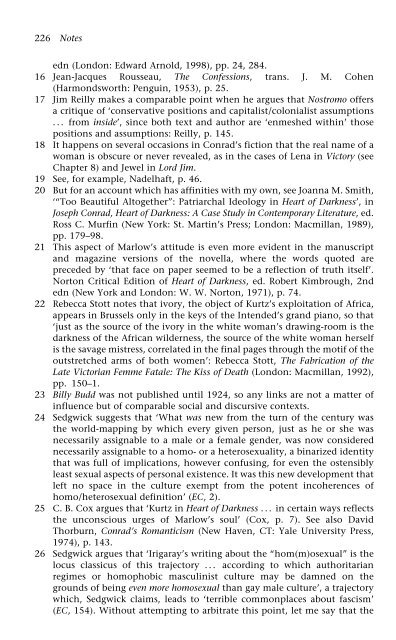Conrad and Masculinity
Conrad and Masculinity
Conrad and Masculinity
Create successful ePaper yourself
Turn your PDF publications into a flip-book with our unique Google optimized e-Paper software.
226 Notes<br />
edn (London: Edward Arnold, 1998), pp. 24, 284.<br />
16 Jean-Jacques Rousseau, The Confessions, trans. J. M. Cohen<br />
(Harmondsworth: Penguin, 1953), p. 25.<br />
17 Jim Reilly makes a comparable point when he argues that Nostromo offers<br />
a critique of ‘conservative positions <strong>and</strong> capitalist/colonialist assumptions<br />
. . . from inside’, since both text <strong>and</strong> author are ‘enmeshed within’ those<br />
positions <strong>and</strong> assumptions: Reilly, p. 145.<br />
18 It happens on several occasions in <strong>Conrad</strong>’s fiction that the real name of a<br />
woman is obscure or never revealed, as in the cases of Lena in Victory (see<br />
Chapter 8) <strong>and</strong> Jewel in Lord Jim.<br />
19 See, for example, Nadelhaft, p. 46.<br />
20 But for an account which has affinities with my own, see Joanna M. Smith,<br />
‘“Too Beautiful Altogether”: Patriarchal Ideology in Heart of Darkness’, in<br />
Joseph <strong>Conrad</strong>, Heart of Darkness: A Case Study in Contemporary Literature, ed.<br />
Ross C. Murfin (New York: St. Martin’s Press; London: Macmillan, 1989),<br />
pp. 179–98.<br />
21 This aspect of Marlow’s attitude is even more evident in the manuscript<br />
<strong>and</strong> magazine versions of the novella, where the words quoted are<br />
preceded by ‘that face on paper seemed to be a reflection of truth itself’.<br />
Norton Critical Edition of Heart of Darkness, ed. Robert Kimbrough, 2nd<br />
edn (New York <strong>and</strong> London: W. W. Norton, 1971), p. 74.<br />
22 Rebecca Stott notes that ivory, the object of Kurtz’s exploitation of Africa,<br />
appears in Brussels only in the keys of the Intended’s gr<strong>and</strong> piano, so that<br />
‘just as the source of the ivory in the white woman’s drawing-room is the<br />
darkness of the African wilderness, the source of the white woman herself<br />
is the savage mistress, correlated in the final pages through the motif of the<br />
outstretched arms of both women’: Rebecca Stott, The Fabrication of the<br />
Late Victorian Femme Fatale: The Kiss of Death (London: Macmillan, 1992),<br />
pp. 150–1.<br />
23 Billy Budd was not published until 1924, so any links are not a matter of<br />
influence but of comparable social <strong>and</strong> discursive contexts.<br />
24 Sedgwick suggests that ‘What was new from the turn of the century was<br />
the world-mapping by which every given person, just as he or she was<br />
necessarily assignable to a male or a female gender, was now considered<br />
necessarily assignable to a homo- or a heterosexuality, a binarized identity<br />
that was full of implications, however confusing, for even the ostensibly<br />
least sexual aspects of personal existence. It was this new development that<br />
left no space in the culture exempt from the potent incoherences of<br />
homo/heterosexual definition’ (EC, 2).<br />
25 C. B. Cox argues that ‘Kurtz in Heart of Darkness . . . in certain ways reflects<br />
the unconscious urges of Marlow’s soul’ (Cox, p. 7). See also David<br />
Thorburn, <strong>Conrad</strong>’s Romanticism (New Haven, CT: Yale University Press,<br />
1974), p. 143.<br />
26 Sedgwick argues that ‘Irigaray’s writing about the “hom(m)osexual” is the<br />
locus classicus of this trajectory . . . according to which authoritarian<br />
regimes or homophobic masculinist culture may be damned on the<br />
grounds of being even more homosexual than gay male culture’, a trajectory<br />
which, Sedgwick claims, leads to ‘terrible commonplaces about fascism’<br />
(EC, 154). Without attempting to arbitrate this point, let me say that the




